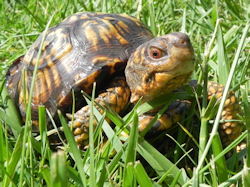|
|
Probably one of the most common turtles is the Red eared slider (RES). Back in the fifties and sixties these were sold in dime stores all across America. Unfortunately little care information was given and most succumbed to poor diet and habitat. There are still a few of those original sliders around that people have had for forty years or more, so we know they can live a long life if kept properly. Below are the basic set up requirements for housing. Young hatchling sliders may be kept in a ten-gallon aquarium for probably their first year, provided they are not overfed which will force them to grow too fast. It is not true that a turtle will not grow larger than the habitat it is kept in. It is also not true that these little green hatchlings stay small. The water level for hatchlings may be deep, however they must have an easy access to a basking area. They need a basking area regardless of water level so they can get completely out of the water to dry off. Just keep in mind, in the wild there are no 'nursery ponds' for wild turtles. They all live in the same big ponds. The easy access basking is key. They are great swimmers, but need to be able to get out of the water easily. Ideally the basking area should be between 80 – 90°F with a water temperature of about 70-75°F. The reason for the basking area being hotter than the water is to encourage the turtles to bask. If the basking temperature is the same as the water temperature they have no reason to leave the water. A healthy turtle will bask for several hours daily. Turtles must have UVB lighting for proper bone and shell growth. There are many different types of uvb lamps available. Make sure you buy one that gives ample uvb output. There are Super UV Coil lamps that claim to be full spectrum lighting and all your reptile needs. Not true, they give very little uvb and some of the coil lamps have even caused eye damage (photo-kerato-conjunctivitis). For a good comparison of uvb lighting of different brands check this link: http://russiantortoise.org/We use uv/heat lamps here. These are mercury vapor bulbs that are a combination of UVB and heat. They should NEVER be used over a ten gallon tank and carefully over a twenty gallon for risk of over heating your turtle. Ideally, no turtle should ever be kept in any small aquarium. To keep the maintenance down it is best to get a filter that is made for a much larger tank than you have your turtle in. Turtles are very messy and water changes will be necessary, but will not be needed as often if you have a good filter system. The external canister filters such as Magnum, Fluval and Filstar, Eheim, are all good types to use. It’s a good idea to keep a water thermometer in the tank to monitor the temperature. If the temperature falls below 65-70°F then a heater should to be added. Using a protective sleeve is recommended to prevent the turtles from breaking the glass, or there are heaters that are made of some type of metal that won’t break. Keep in mind that as your turtle grows so will the size of your aquarium. One four-inch turtle may be maintained in a 20Long tank, but if you add another turtle you need to go to a 40 or larger aquarium. A full-grown female slider can reach 12” or more, so it will need an aquarium size of about 70-100 gallons to be maintained properly. Optimally sliders are best kept in outdoor ponds, but since many are not able to have an outdoor pond then following the above will keep your turtles happy and healthy. I always feel it’s best to go right for the large tank from the start to avoid the expense of buying multiple tanks over the years. Check places like Ebay and Craigslist for used set ups too. You can get some good used equipment sometimes for free or quite inexpensive. RES should be fed a variety of foods. Reptomin floating food sticks, Turtle Brittle, Aqua Max are all good pellet food, but they should also be fed a variety of greens such as romaine, chicory, mustard greens, dandelion and will also consume duckweed, water lettuce, water hyacinth and anacharis plants. In addition to greens, a few times a week feed them cooked chicken, raw or cooked shrimp, smelts, sardines (unsalted in water if buying a can), assorted fish or snails. They will also consume crickets, mealworms or superworms so gut loading these insects with a good calcium supplement meal is a good way to get extra calcium into your turtle. Another good way is to add a cuttlebone, the kind used for birds, to the tank. They will nibble at that. A great place to buy Turtle Brittle and Aqua Max as well as the UV/heat lamps is www.carolinapetsupply.comFeed your turtle as much food as it will consume in about 10-15 minutes, no more than that. RES are notorious beggars and will beg for food every time you walk past them. Don’t give in; it’s not good for them. Just feed them once a day and let them grow at a slow steady pace.
| |||||||||||||||









_small.jpg)